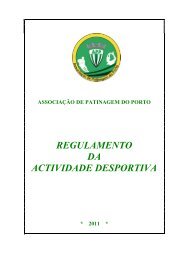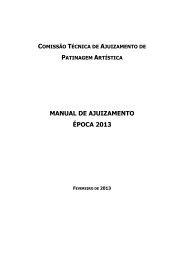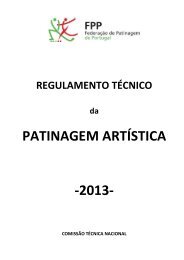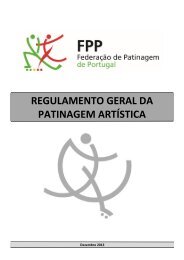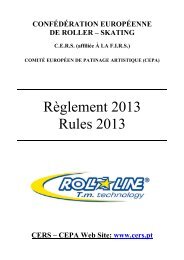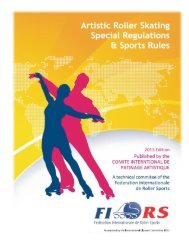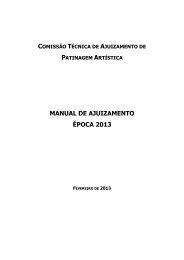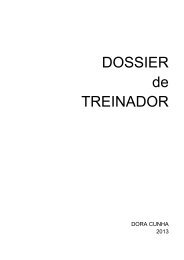Create successful ePaper yourself
Turn your PDF publications into a flip-book with our unique Google optimized e-Paper software.
FR 6.13<br />
itself, and the exit. These three factors comprise the basis of evaluation for all spins, and each<br />
should be given careful consideration when determining a score. There are a variety of methods by<br />
which spins may be satisfactorily performed, as well as many methods of entering and exiting the<br />
spins. Any procedure, which spots the spin, produces a sufficient number of rotations, and stays<br />
within the accepted rules of form, shall be considered a good method. Any method not meeting<br />
these requirements should be downgraded in proportion to its shortcomings.<br />
Two Foot Spins Classified<br />
6.13.01 There are a variety of spins, which may be accomplished in roller free skating. Among the most<br />
basic are the spins executed on both feet. Among them are:<br />
• Flat Foot<br />
• Heel and Toe, Toe and Heel<br />
• Crossed Foot, Crossed Toe, Crossed Heel<br />
• Faked Cross, Faked Cross Toe, Faked Cross Heel<br />
6.13.02 The FLAT FOOT spin is nearly impossible to execute on rollers unless the performer uses very<br />
loose action on the skates, uses small skates, or performs the spin with the feet set wide apart. The<br />
Flat Foot is a combination of Inside edges (one forward and one backward) with at least three<br />
wheels of each skate rolling on the surface. Most so-called Flat Foot spins are actually Heel and<br />
Toe spins.<br />
6.13.03 The HEEL AND TOE is a combination of the heel wheels of one skate and the toe wheels of the<br />
other. The reason it is so often confused with the Flat Foot is that it takes a discerning eye to notice<br />
that the front wheels executing the Inside Forward edge are either off the skating surface or sliding,<br />
while the rear wheels of the Inside Back edge are doing the same thing. This spin is relatively to<br />
accomplish, and as such, is among the most common found in free skating programs. Other<br />
varieties of this spin are the Two Toe spin uncrossed, and the uncrossed Two Heel spin.<br />
6.13.04 When properly executed, the CROSSED FOOT spin consists of two Outside edges, one forward<br />
and one backward. The heels and knees are turned out and the feet are crossed. While this is a<br />
pigeon-toed movement, it is in excellent form due to the crossing of the feet. During the spin, the<br />
knees should be kept as nearly straight as possible to avoid bad form. This spin may also be done<br />
on toes or heels.<br />
6.13.05 The FAKED CROSSED FOOT is a variety of the Crossed Foot but is executed on a combination<br />
of opposite edges, both moving in the same direction. For example, a leading Outside Forward<br />
edge crossed over a trailing Inside Forward, or an Inside Back edge crossed over a leading Outside<br />
Back edge. This spin may also be performed on toes or heels and, while this type of spin is quite<br />
common, it carries a limited amount technical merit and is often skated out of control.<br />
FR 6.14<br />
One Foot Spins Classified<br />
6.14.01 No attempt will be made to classify these spins into the various body positions, since a variety of<br />
positions may be assumed in nearly all of them. There are three major categories of one foot spins:<br />
6.14.02 UPRIGHT spins are those in which the body remains in a standing position.<br />
6.14.03 A SIT spin is a spin in which the hip is as low (or lower) than the tracing knee.<br />
6.14.04 A CAMEL spin is executed with the body extended in a continuous line from head through free<br />
foot, this line being parallel to the skating surface. Two additional versions of the Camel spin are<br />
the Inverted and the Layover. In the Inverted Camel, the hips and shoulders face front side up,<br />
giving the impression of the skater facing with back to the skating surface. The Layover Camel is<br />
accomplished with the shoulder line and the hip line perpendicular to the skating surface.<br />
6.14.05 One Foot spins are also divided into four classes:<br />
6.14.06 EDGE spins definitely trace a circle, with no wheels pivoting. All four wheels are not necessarily<br />
in contact with the skating surface, but more often than not, the three that are should remain rolling.<br />
CIPA RULE BOOK 2013 50




